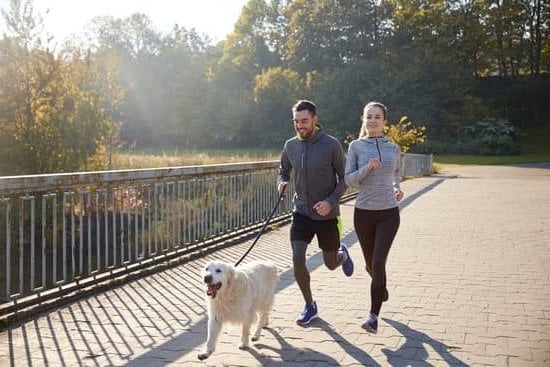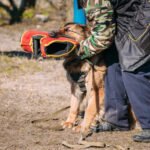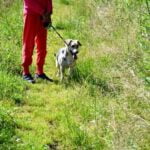Training your dog to go back home is an essential skill that can provide peace of mind and safety for both you and your furry companion. By teaching your dog to find their way back, you are ensuring their well-being and security, especially in case they ever become lost or disoriented.
This article will provide you with a comprehensive guide on how to train your dog to go back home, covering everything from understanding your dog’s natural instincts to utilizing technology for added security.
Understanding your dog’s natural instincts is crucial when it comes to training them to go back home. Dogs have a remarkable sense of direction and navigation, using their keen senses to find their way back. Establishing a consistent routine and teaching basic obedience commands are also fundamental aspects of the training process. Furthermore, introducing scent and landmark training as well as utilizing technology can greatly aid in solidifying this crucial skill for your dog.
The journey of training your dog to go back home may come with some challenges, but with patience and dedication, it is a rewarding endeavor that can strengthen the bond between you and your pet. Through the following sections in this article, we will walk you through each step of the process and provide tips for troubleshooting common challenges that may arise during training.
So, grab some treats and get ready to embark on this important journey with your furry companion.
Understanding Your Dog’s Natural Instincts
Dogs have an incredible natural sense of direction and navigation, often relying on their keen senses to find their way back home. This instinct is deeply ingrained in their DNA, making it crucial for pet owners to understand and harness this ability. By understanding how your dog uses their senses to find their way back home, you can effectively train them to navigate various environments and return safely.
One of the key aspects of understanding your dog’s natural instincts is recognizing the importance of this instinct in training. Dogs rely heavily on scent and landmarks to orient themselves, allowing them to navigate familiar routes effortlessly. By tapping into these natural abilities, you can enhance your dog’s training to go back home, ensuring their safety and security in various situations.
To train your dog to utilize their natural instincts for returning home, it’s essential to establish a consistent routine. This routine includes setting regular feeding and exercise schedules, as well as creating a familiar environment for your dog to feel at ease. By providing a structured and predictable routine, you can help reinforce your dog’s sense of familiarity and comfort in their surroundings, ultimately aiding them in finding their way back home when needed.
- Feed your dog at the same times each day
- Establish regular walking and exercise schedules
- Create a comfortable living environment with designated resting spots
By understanding your dog’s natural instincts and establishing a consistent routine, you can lay the groundwork for effective training on how to train dog to go back home. This foundation will set the stage for further obedience training and the introduction of scent and landmark techniques that are essential for reinforcing your dog’s ability to navigate back home.
Establishing a Consistent Routine
Creating a consistent routine is essential when training your dog to go back home. Dogs thrive on predictability and structure, so establishing a regular schedule for feeding, exercise, and rest will greatly aid in their ability to navigate back home when needed.
Setting a Regular Feeding and Exercise Schedule
One of the first steps in establishing a routine for your dog is to set regular feeding and exercise times. By feeding your dog at the same times each day, they will learn to anticipate when they will have access to food and will be less likely to wander off in search of it. Additionally, providing daily exercise not only keeps your dog physically healthy but also allows them to become familiar with their surroundings.
In addition to regular routines for feeding and exercise, creating a familiar environment within your home helps your dog feel comfortable and secure. Designate specific areas for eating, sleeping, and playing, and maintain consistency in these areas. When your dog feels at ease within their living space, they are more likely to recognize it as their home base and return there if they get lost.
Training your dog can be challenging yet rewarding. This may take some patience but incorporating consistency into their daily routine will ultimately help ingrain the concept of “home” into their psyche
Teaching Basic Obedience Commands
To train your dog to come when called, start by using a leash and collar for control. Begin in a quiet, familiar environment and say the command “come” while gently pulling the leash towards you. When your dog follows the command and approaches you, reward them with praise, treats, or their favorite toy. Repeat this process multiple times during each training session to reinforce the association between the command and the desired action.
Similarly, teaching your dog to stay is important for their safety when navigating back home. Start by commanding your dog to sit, then say “stay” while taking a step backward. If they remain in place for a few seconds, reward them with positive reinforcement. Gradually increase the distance and duration of the stay command as your dog becomes more comfortable with the exercise.
It’s important to remember that every dog has its own learning pace, so be patient and consistent with your training efforts. Using positive reinforcement such as treats or praise will encourage obedience and create a strong bond between you and your furry friend. Incorporating these basic obedience commands into your daily routine will not only enhance their training but also contribute to their overall well-being and safety.
By mastering these fundamental commands, you are equipping your dog with valuable skills that can be crucial in ensuring their safe return home in case they ever get lost or separated from you. Regular practice and positive reinforcement will help solidify these commands so that they become second nature to your loyal companion.
Introducing Scent and Landmark Training
When it comes to training your dog to go back home, introducing scent and landmark training can be a crucial step in ensuring their safety and well-being. Dogs have an incredible sense of smell, and they can use this to navigate their way back home. By incorporating scent trails and designated landmarks into their training, you can help them develop the skills they need to find their way back if they ever get lost.
Scent and landmark training involves teaching your dog to recognize specific scents and markers that will lead them back home. You can start by leaving a familiar scent trail for them to follow during walks or outings, gradually increasing the distance from your home. Additionally, you can set up designated landmarks along your regular walking routes that your dog will learn to recognize as they make their way back home.
To introduce scent and landmark training effectively, it’s important to be patient and consistent with your efforts. Use positive reinforcement techniques such as treats or praise when your dog successfully follows a scent trail or locates a familiar landmark. Over time, they will associate these scents and markers with the path leading back home.
Using technology such as GPS tracking devices can also complement scent and landmark training, providing added security in case of emergencies. This combination of traditional training methods with modern technology can further reinforce your dog’s understanding of how to find their way back home.
| Training Method | Key Points |
|---|---|
| Scent Trails | Gradually increase distance from home, use familiar scents |
| Landmark Recognition | Designate specific landmarks, consistently use on outings |
| Technology Integration | Utilize GPS tracking for added security in emergencies |
Using Technology to Aid in Training
As technology continues to advance, pet owners now have access to a wide range of tools and devices that can aid in training their dogs. One of the most useful technological advancements for training a dog to go back home is the GPS and tracking devices. These devices can provide added security and peace of mind, especially for pet owners who live in large areas or have dogs with a strong sense of adventure.
GPS and tracking devices work by allowing owners to pinpoint their dog’s location in real time through the use of a smartphone or computer. This can be incredibly helpful in case your dog gets lost or wanders off during outings. By utilizing these devices during training sessions, you can also train your dog to respond to the GPS tracker in case of emergencies, ensuring that they can find their way back home even if they stray too far.
In addition to GPS and tracking devices, there are also various apps available that can assist in training your dog to go back home. These apps often provide features such as virtual boundaries, where pet owners can set up safe zones for their dogs and receive alerts if their pets leave those areas.
Some apps also offer training modules and tips specifically designed to help teach dogs to navigate back home, making them valuable resources for pet owners looking to supplement traditional training methods with modern technology.
Finally, it’s important for pet owners to understand that while technology can be an effective tool in aiding the training process, it should not replace traditional training methods entirely. Instead, GPS trackers and apps should be used as supplements to reinforce training and provide an extra layer of security for both the owner and the dog.
| Technological Advancements | Benefits |
|---|---|
| GPS and Tracking Devices | Real-time location tracking for added security |
| Training Apps | Virtual boundaries and specific training modules |
| Supplementing Traditional Training Methods | Using technology as reinforcement rather than a replacement |
Practicing and Reinforcing the Training
Importance of Consistent Practice and Reinforcement
Consistency is key when it comes to training your dog to go back home. It’s important to regularly practice the commands and techniques you’ve taught your furry friend. By reinforcing the training on a consistent basis, your dog will be more likely to remember and follow through in a real-life situation.
This means conducting regular training sessions, even after your dog has shown progress. The more often you practice, the better your dog will become at finding their way back home.
Conducting Regular Training Sessions
Set aside specific times each day to work on the training with your dog. Whether it’s practicing obedience commands or incorporating scent and landmark training into walks, consistent sessions will help reinforce what your dog has learned. Be patient and understanding during these sessions, as it may take time for your dog to fully grasp the training. Consistency also includes using the same cues and signals each time, so your dog learns to associate them with the desired action.
Using Real-Life Scenarios to Reinforce the Training
Incorporating real-life scenarios into your training can further reinforce your dog’s ability to find their way back home. Take supervised outings where you let your dog navigate on their own, always within safe environments of course. Practice using familiar scents and landmarks as cues for them to return home.
Additionally, allow opportunities for positive reinforcement when they successfully make their way back. These real-life experiences will solidify their skills and build confidence in their ability to navigate back home independently.
By consistently practicing and reinforcing the training, pet owners can feel confident that their dogs are well-prepared in finding their way back home in various situations.
Troubleshooting Common Challenges
Training a dog to go back home is an essential skill that every pet owner should invest in. This training ensures the safety and well-being of your furry friend, especially in case they ever get lost or separated from you.
While the process of teaching your dog to find their way back home can be incredibly rewarding, it also comes with its fair share of challenges. Here’s how to address common obstacles that may arise during the training process:
- Addressing common obstacles: When training your dog to go back home, you may encounter challenges such as distractions, lack of focus, or difficulty in understanding commands. It’s important to recognize these obstacles and develop strategies to overcome them.
- Dealing with distractions: Dogs are naturally curious creatures, and they may get easily distracted during training sessions, especially when outdoors. To address this challenge, it’s crucial to find a quiet and familiar environment for training where your dog can focus and learn without too many external stimuli.
- Tips for staying patient: Training a dog to go back home requires patience and consistency. It’s essential to remain calm and composed when facing challenges during the training process. Remember that each dog is unique, and some may take longer to grasp the concepts of navigating back home than others.
Despite these common challenges, it’s important to stay committed to the training process and continue reinforcing the skills needed for your dog to find their way back home.
As you embark on this journey with your furry friend, keep in mind that troubleshooting common challenges is all part of the learning process. With dedication, patience, and consistent practice, you can overcome these obstacles and successfully train your dog to go back home.
Remember that investing time in this crucial training will not only enhance the bond between you and your pet but also provide a sense of security knowing that they have the ability to return home safely if ever separated from you.
Conclusion
In conclusion, training your dog to go back home is a crucial skill that every pet owner should prioritize. By understanding your dog’s natural instincts, establishing a consistent routine, teaching basic obedience commands, introducing scent and landmark training, using technology to aid in training, and practicing and reinforcing the training, you can ensure that your furry friend has the necessary skills to find their way back home in case of an emergency.
It’s important to remember that patience is key when embarking on this journey with your dog. Be consistent with your training sessions and always use positive reinforcement to encourage obedience. Additionally, don’t hesitate to seek professional help or guidance if you encounter any challenges along the way.
By investing time and effort into training your dog to go back home, you are not only ensuring their safety but also strengthening the bond between you and your beloved pet. The peace of mind that comes with knowing your dog has the skills to navigate their way back home is invaluable.
Frequently Asked Questions
How Do I Train My Dog to Return Home?
Training your dog to return home requires patience, consistency, and positive reinforcement. Start by teaching them a reliable recall command in a safe, enclosed area and gradually increase the distance. Use high-value rewards and practice regularly to reinforce this behavior.
What to Do if Your Dog Refuses to Go Home?
If your dog refuses to go home, it’s essential to stay calm and avoid chasing or forcing them. Instead, try using their favorite toys or treats to encourage them to come towards you. You can also use a long line to gently guide them back home while giving lots of praise.
How Do I Train My Dog to Return?
Training your dog to return is a crucial skill that ensures their safety and allows them more freedom during walks or off-leash activities. Begin by using a distinct recall cue like “come” and reward them with praise, treats, or play when they respond correctly. Consistent practice in different environments is key to reinforcing this behavior.

Welcome to the blog! I am a professional dog trainer and have been working with dogs for many years. In this blog, I will be discussing various topics related to dog training, including tips, tricks, and advice. I hope you find this information helpful and informative. Thanks for reading!





